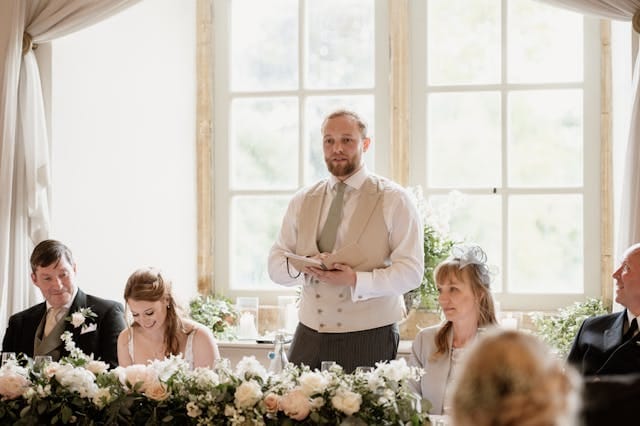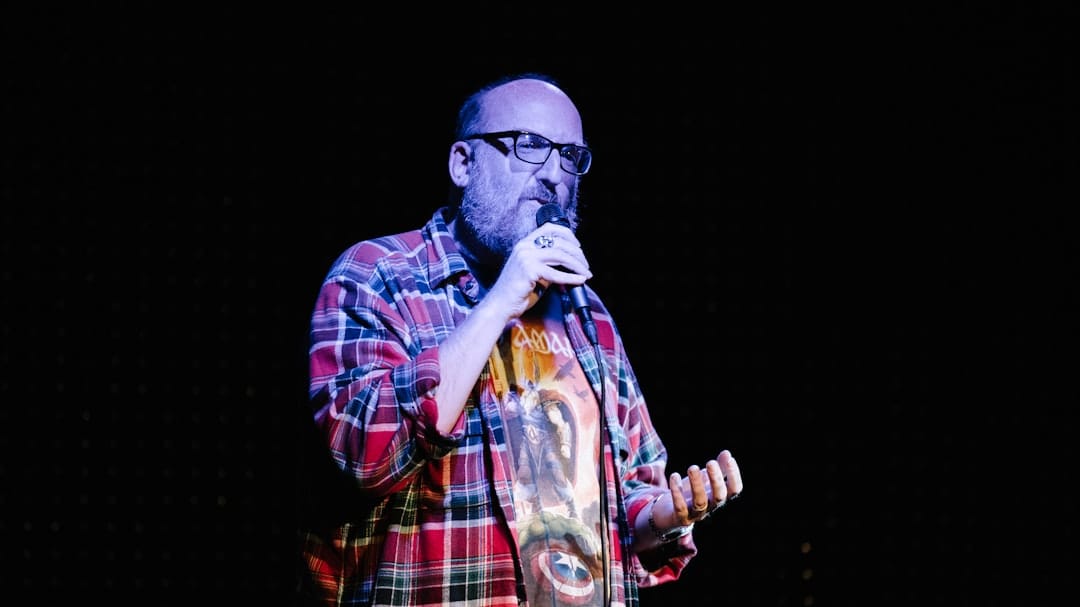How to Become a Master Chef of the Word Salad

Did you know that people’s number one fear is public speaking?
It’s hard to believe. Individuals aren’t nearly as scared about heights, spiders, confined spaces - or even death - as they are about speaking in front of a crowd.
Yet people speak in public all the time. Some even make a living doing it.
A few years ago, my sister got married. As her favorite older brother, I had the honor - and the pressure - of giving a speech.
It was an outdoor reception under a large tent with about 100 guests.
I was nervous, waiting as other speakers went ahead of me: the MC, the parents, the best man, the maid of honor.
They paired me with my youngest sister to give our speeches as siblings of the bride. She went first. I stood by and waited anxiously.
Finally, it was my turn.
I took the microphone, and suddenly, all my nervous energy was gone. I felt calm.
I started to speak.
I opened by welcoming everybody to the wedding and thanking them for coming. Then I followed with some lighthearted teasing.
I told the story about the first time I met her now-husband - throwing in the occasional joke, but mostly sticking to the facts.
I spoke about the time the three of us shared an apartment in Calgary. I leaned into the sentimentality here, just a little, talking about how I watched their love grow and deepen.
Then I completely switched gears.
“I also got to see them argue.” I said.
The guests suddenly became quiet.
Where was I going with this?
I spoke about how arguments can reveal a lot - if you pay attention. I spoke about how the real sign to end a disagreement isn’t always what gets said, but how it’s said.
I turned to my new brother-in-law.
“You need to hear this,” I told him.
“There’s always a tell - something subtle. Maybe it’s a shift in tone. Maybe they change the topic from the fight itself to the way you’re arguing.”
Then I paused.
“This is important to know because…”
Another pause.
“Dude, that’s how you know you just won the argument.”
The whole tent exploded with laughter. The groom’s dad was nearly jumping out of his chair.
“So sit back - and enjoy your victory.”
That was the best speech I’ve ever given - but it didn’t happen overnight.
My sister and her husband were engaged for over a year - giving me plenty of time to prepare what I wanted to say.
I played with different stories and jokes. I researched what other people say at weddings.
In the past, I’d keep notes with key points I could look to if I ever got stuck.
But this time, I went up with nothing written, and did the whole thing from memory.
It wasn’t perfect.
My original version of the speech was longer.
However, when I got that huge laugh out of the audience, I realized - I can’t go up from this. Time to wrap it up.
I should have ended it there. Instead, I thanked my dad for hosting and offered a toast to the bride and groom.
It still worked, but it’s something I’ll remember for next time.
All night long, guests were coming up and telling me what a great job I did and how funny I was. I was happy everyone enjoyed it.
You don’t have to be a comedian to give a good speech, but it helps to know what you’re doing.
These are some of the public speaking lessons I’ve learned through experience.

Public speaking is a muscle.
The more you use it, the easier it gets.
When I think about how I got comfortable speaking in public, I recall an experience I had in high school.
In grade 11, I had to give a presentation in almost every single class I was taking - five presentations in two weeks.
Each of them was a significant portion of my grade.
My first presentation was rough. I knew the subject matter, but my speaking was terrible: lots of ums and ahs, rushing through my material, mumbling, stuttering.
Everyone seemed to understand. They applauded at the end, like they would for anyone else, and I took my seat.
Each talk after that got better.
By the time I got to my last presentation, I was excited to get up and speak in front of the class.
I was comfortable and confident in what I was saying because I had put in the reps.

Know your audience - especially if you’re trying to be funny.
After giving my speech, my sister came up to me.
“You know what your style of humor is?” she said. “You find the line between appropriate and inappropriate, and then tap dance right at the edge.”
She was right.
I didn’t cross the line. But I played close enough that the audience was fully engaged, wondering if I would.
In public school, our class had a module on public speaking. Each of us gave a short speech on a topic of our choosing.
I bombed this presentation, but my friend knocked it out of the park.
Many of the boys gave speeches about sports - myself included - but he went in a different direction.
The talk he gave was on the subject of toupees.
With such an odd topic, and his deadpan way of delivering the speech, the entire class was in stitches - our teacher included.
She had him give his speech again at an assembly, and then another time during a school concert when our parents were in attendance.
Everybody loved it.
I think about actors like Ryan Reynolds in his movies like Deadpool and Van Wilder where the comedy is edgy, inappropriate, and completely over the line for most people.
There’s an audience for this type of material, but it’s not going to go over well in most settings.
Don’t try to be funny by dropping F-bombs, raunchy sexual jokes, or politically incorrect material - unless you’re absolutely certain that your audience is into it.

Mind your pacing, silence and filler words.
I’ve given speeches where nervousness took over—I spoke too fast, and the ums and ahs were everywhere.
That’s normal when you’re new, and most audiences are forgiving.
But a good speech uses pacing, silence, and intentional word choice.
There’s a memorable scene in Look Who’s Back where Hitler gives a speech. The crowd expects a joke - but he just stands there silently.
The tension builds. People get uncomfortable. And when he finally speaks, they’re hanging on every word.
I’m not telling you to stare down your audience, but taking a moment at the beginning of your talk can help set the stage for your entire presentation.
When you stand up - before saying anything - take a deep breath.
This will calm your body and mind. It’s a reminder to slow down and speak in a controlled manner.
Many of the ums and ahs happen because we aren’t paying attention. We’re just talking haphazardly.
If you take control over the words you say, you can cut filler words out completely.
Don’t be afraid to be silent for a moment as you regain composure, remember a point, or look at your notes.
Your audience needs to understand what you’re saying.
That’s why speaking slower is often the better choice.
Some public figures, like Ben Shapiro, are known for speaking a mile a minute, rattling off a bunch of facts, big words, and talking points in the process.
You don’t have to be like that.
Speak at a comfortable pace, as you would if you were talking to a group of friends or family members.
If you find yourself losing control of your pacing, take another deep breath. It’s okay - your audience will wait.

Learn from the best.
The internet is full of podcasts, speeches, comedy acts, and rants. Find the ones that match your style.
Growing up, I loved watching stand-up comedy. I even thought about getting into it myself.
It’s impressive how someone can get up on stage with just a microphone, and entertain a crowd for an evening.
Each comedian has a distinct style. I often draw from their strengths when I speak.
Mitch Hedberg was the king of one-liners, which always seemed to come out of left-field.
Doug Stanhope is like your crazy uncle who shows up drunk and goes off on an unhinged rant. It’s chaotic—but hilarious.
A lot of comedians are very observant, and tell the truth in a funny way that resonates. Bill Burr, George Carlin, and Dave Chappelle are popular examples of this.
You can borrow their style to add humor.
It’s not just comedians I’ve borrowed from either.
Henry Rollins is an actor, author and the former lead singer of Black Flag.
He goes on speaking tours, and tells stories from his life, and they’re very engaging.
I studied his recordings and borrowed parts of his storytelling style.
Joe Rogan’s podcast is wildly popular, and it’s easy to see why. He’s genuine, curious, and funny. Despite his fame, he’s relatable.
He’s not pretending to be someone he’s not, and neither should you.
Devon Stack’s Insomnia Stream on his channel ‘Blackpilled’ taught me how to use silence for emphasis.
Nick Fuentes, host of the controversial ‘America First’ stream, helped me get better at improvising. Watching him taught me how to stay sharp, relevant, and entertaining - even when going off-script.
I’ve listened to many excellent speakers over the years, and I’ve incorporated their best points into my style of speaking.
Find the speakers that appeal to you.
How do they speak?
Can their methods work for you, without coming across as inauthentic?

Practice makes perfect.
Learning anything new takes repetition. I’ve often rehearsed speeches multiple times before delivering them.
For my sister’s wedding speech, I ran ideas past friends before deciding what to use.
However, more than anything, I found myself visualizing what I was going to say.
I wasn’t sure how to word one part of it; but I decided I’ll figure it out once I’m holding a microphone in front of 100 people.
When the time came, I got my point across smoothly.
That approach won’t work for everyone - especially beginners - but visualization is a powerful tool.
Practice what you’re going to say. Use your notes if you’re allowed. Repeat it several times.
Then, when it’s time, it’ll feel just like practice.

Watch your surroundings.
Our uncle was DJing the wedding. He’s been doing this for a long time.
One thing he pointed out was how well I handled the microphone.
I held it a few inches away from my lips as I spoke, allowing the sound to travel clearly.
People who aren’t used to microphones often turn their head or move their arms as they speak. This causes the sound to cut in and out, making it hard for people at the back to hear.
Similarly, if there’s a podium, it can be tempting to lean on it, but slouching over looks awkward. You look best when you stand up straight.
I’ve seen people pace around the stage while they spoke, and accidentally fall off the edge.
So take note of your environment before getting up and delivering your message.

Over the years, I’ve spoken at weddings, parties, corporate events, school presentations, church functions, and several other places.
Most went well. A few bombed. Some were legendary.
Each speaking engagement taught me something , but the speech at my sister’s wedding made me realize:
If you’re authentic, and speak from the heart - people will listen.
If you can make them laugh - they’ll love you.
Public speaking isn’t about having the loudest voice, or showing everybody how clever you are. It’s about connecting with your audience.
So if you find yourself standing in front of a crowd of people with a mic in hand - don’t panic.
Keep this advice in mind.
Take a deep breath.
Look into the crowd.
Smile.
And then speak.
You have more to say than you realize.
If you enjoyed this article, bookmark this page and remember to Subscribe.
Check out my Substack:
http://crossedstakes.substack.com
And follow me on socials:
Facebook: https://www.facebook.com/profile.php?id=61577920320315
Twitter: https://x.com/peterm82321
Instagram: https://www.instagram.com/peter477894/
Youtube: https://www.youtube.com/@oreilly81
Thanks for reading.
God Bless.
Member discussion